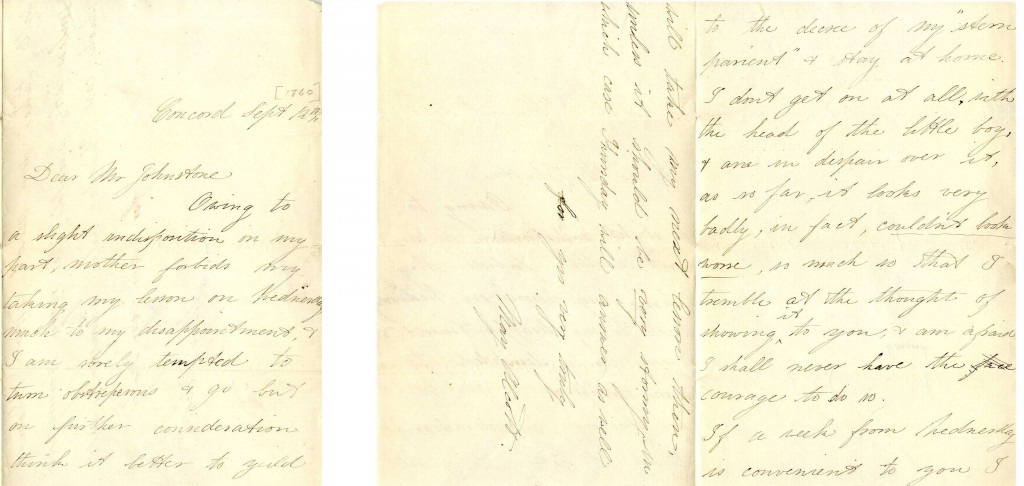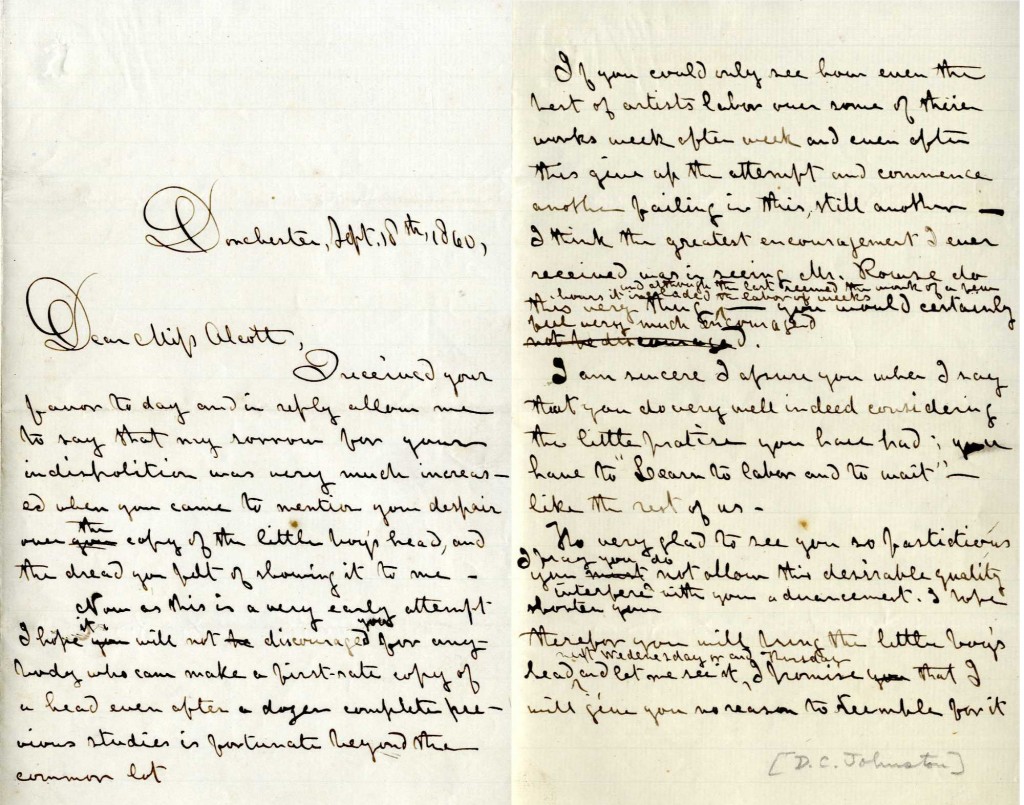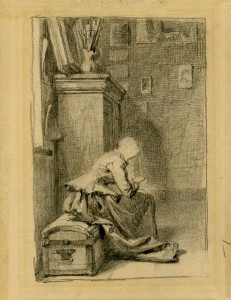In August and December of 2010, the AAS received additional gifts to supplement the already delectable David Claypoole Johnston Family Collection. (You can see a portrait of the artist and read a short bio as part of the online exhibition of Portraits at the American Antiquarian Society.)
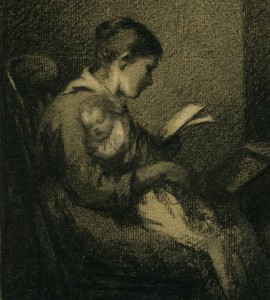
Of the material which came (in the form of three gifts), one included several pieces by students who worked with David Claypoole Johnston. One of his more notable students?
Author Louisa May Alcott.
In 1933 the Society received (again by gift) much of the D.C. Johnston Collection, and in that bequest was a letter to Johnston from his young student.
The letter dated September 12, 1860 from Concord reads:
Dear Mr. Johnston,
Owing to a slight indisposition on my part, mother forbids my taking my lesson on Wednesday much to my disappointment, & I am sorely tempted to turn obstreperous & go but on further consideration think it better to yield to the decree of my “stern parent” & stay at home. I don’t get on at all, with the head of the little boy, & am in despair over it, as so far, it looks very badly, in fact, couldn’t look worse, so much is that I trembled at the thought of showing it to you, & am afraid I shall never have the courage to do so. If a week from Wednesday is convenient to you I will take my next lesson then, unless it should be very story, in which case Thursday will answer as well for yours very truly
May Alcott
Johnston’s reply, also included in the AAS collection, was careful, patient and kind. He writes to Alcott from Dorchester on September 18, 1860:
Dear Miss Alcott,
I received your favor to day and in reply allow me to say that my sorrow for your indisposition was very much increased when you came to mention your despair over the copy of the little boy’s head, and the dread you felt of showing it to me.
Now as this is a very early attempt I hope it will not discourage you for any body who can make a first-rate copy of a head even after a dozen complete previous studies in fortunate beyond the common lot. If you could only see how even the rest of artists labor over some of their works week after week and even after this give up the attempt and commence another failing in this, still another – I think the greatest encouragement I ever received was in seeing Mr. Rouse do this very […] you would certainly feel very much encouraged [and although the last seemed the work of a few hours it the labor or weeks].
I am sincere I assure you when I say that you do very well indeed considering the little practice you have had; you have to “learn to labor and to wait” – like the rest of us.
Tho’ very glad to see you so fastidious I pray you do not allow this desirably quality interfere with your advancement. I hope […] you therefore you will bring the little boy’s head next Wednesday or Thursday and let me see it and I promise that I will give you no reason to tremble for it.
Johnston’s letter itself seems a work-in-progress – as are many of his drawings. Constantly being tweaked, revised, amended…
There are many things we will never know about the exchange – or about whom Johnston’s students were. We do know David Claypoole 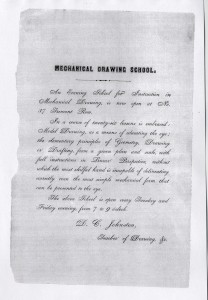 Johnston taught a Mechanical Drawing School (see the advertisement at right), and that Johnston and his family collected students’ work, or were given them. But many of these new student pieces are unsigned (the same is true of the book item of student work in Box 6 Folder 1.49). And yet, like it or not, the temptation is there (how exciting would it be, if in this cache there was a piece drawn by the same hand that penned Little Women?) to find pieces and assign them – even without proper clues.
Johnston taught a Mechanical Drawing School (see the advertisement at right), and that Johnston and his family collected students’ work, or were given them. But many of these new student pieces are unsigned (the same is true of the book item of student work in Box 6 Folder 1.49). And yet, like it or not, the temptation is there (how exciting would it be, if in this cache there was a piece drawn by the same hand that penned Little Women?) to find pieces and assign them – even without proper clues.
L.M. Alcott is known today almost by her non-signer status, one of the tantalizing things about her is the mystery surrounding how many items she did author. Experts agree we will never know her entire canon. Her ‘anthologies’ will perhaps never be complete. Madeleine Stern and Leona Rostenberg, for example, discovered the thrill-ier side of Alcott, discovering some of her ‘nameless’ pieces in periodicals of the nineteenth-century in letters at Houghton Library, Harvard.
Even if the archive has the pieces listed now as ‘unidentified’ for artist, we still have all the pieces ready for the historian-cloaked version of Sherlock Holmes to just come and sleuth-ily put it all together. And that is part of the fun working in a place like AAS. We – in the back of the archive – compile, add-on, update and push out all the newest things so you can come into the reading room gasp, scream, sob, clap and enjoy history. While leaving “creator not known” can be frustrating, it can equally be the makings, the bread crumbs, if you will, of a future project for a researcher. Of the things unknown.
Interested yet? Take a look at the new pieces listed in the Additions section of the online illustrated inventory.

